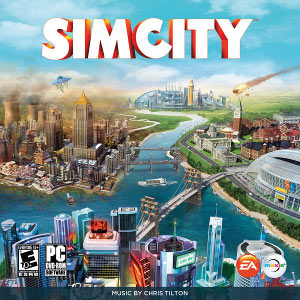SimCity Original Soundtrack
 |
Album Title: SimCity Original Soundtrack |
| Record Label: Electronic Arts |
|
| Catalog No.: N/A |
|
| Release Date: February 12, 2013 |
|
| Purchase: Download at iTunes |
Overview
It’s sad to think that some years down the road, the 2013 version of SimCity won’t be so much remembered for the game’s inherent qualities or flaws – although according to many reviews, the game features plenty of both. Announced as a reboot of the SimCity franchise after the experiment that was 2007’s SimCity Societies, SimCity benefited from immense amounts of gamer goodwill, highlighting how much affection many still carried for the series that started in 1989 with SimCity, and which together with Civilization and Populous came to define the genre of god games. Sadly, all hopes pinned on SimCity being a glorious revival of the franchise went up in smoke upon the game’s release. Saddled with DRM measures that required gamers to be constantly connected to the server while playing, SimCity‘s launch was an unmitigated disaster, as EA failed to provide enough servers, which resulted in customers often being unable to actually launch the game. Other issues included long loading times, deleted save stats, and plenty of in-game bugs once gamers actually managed to run SimCity. Things became bad enough for online retailer Amazon to temporarily withdraw the game from its marketplace.
It’s no surprise then that all these negative experiences overshadowed many of SimCity‘s intriguing aspects. Among these was an orchestral score by Chris Tilton. In the course of the 2000s, Tilton had begun to step out of the shadow of his mentor Michael Giacchino and had shown himself to be a more than capable composer of impressive action scores like Black and Mercenaries 2: World in Flames, while also displaying a more playful side with Night at the Museum: Battle of the Smithsonian. Tilton’s first game project since 2009, SimCity‘s score would be a re-think of the distinctive sound that previous SimCity games had established, according to pre-release interviews with the composer. What Tilton and the developers emphasised most in early interviews though was the interactive nature of the music, as it would respond fluidly not only to the city’s stage of development, but for example also to how close or far players would zoom in or out with the camera during gameplay. It bears quick mention that this approach can be read as a refinement of the way Soyo Oka had already scored the SNE version of the original SimCity – variations upon a theme to reflect the city’s growth. This indicated that 2013’s SimCity would at least in one regard carry on the franchise’s musical tradition. SimCity‘s digital album release caused some surprise, as EA-affiliated music publisher E.A.R.S. took the same approach as Activision did with Call of Duty: Black Ops II some months earlier, releasing an album almost two and a half hours long – still a massive running time for any Western game score release.
Body
Considering that the high-quality music of the SimCity franchise – particularly SimCity 3000 and SimCity 4 – has quite a dedicated fan base, what are series fans to make of Tilton’s statement that SimCity would change musical direction? Even a cursory listen to the composer’s new score will reveal that SimCity comfortably fits into the franchise’s musical canon – the paint job might be different, but the engine is still largely the same. As on the above mentioned SimCity titles, SimCity‘s music is based on interlocking layers of relatively short rhythmic and melodic phrases, which can be easily added and subtracted by the composer to develop a piece. Not surprisingly, SimCity‘s audio director Kent Jolly has quoted the minimalist music of Philip Glass, Steve Reich and Terry Riley as an influence on the game’s music, although it’s necessary to add that Tilton’s compositions are considerably lusher and more melody-oriented than the usually more abstract works of Reich and Riley.
It makes sense that Tilton would stick with this layer-based model to structure his music on SimCity, as it allows him to gradually change a composition’s timbre and character with relative ease and achieve the required interactivity for the music in-game. The absence of longer-winded musical statements and the generally benign mood of the score helps it to easily play as background music during gameplay. Outside of the game, Tilton’s modular approach works just as well as that deployed by other composers on previous SimCity scores, at least during SimCity‘s first two thirds. Tilton’s careful layering of instruments, rhythms and motifs is intricate and dense enough that the soundtrack can easily hold listeners’ attention – during most of the album’s orchestral compositions, there’s always something happening in the piece’s fore- and background. And of course, as has become typical for the SimCity franchise, SimCity‘s score is an optimistic affair that manages to find just the right balance between idyllic contemplation and bustling activity, the latter still the most suitable way to score the myriad of inhabitants and processes underpinning an evergrowing metropolis.
The main change that will become apparent right from the opening track “SimCity Theme” is that the jazz/light rock music which put a gentle groove underneath the expanding cities of SimCity 3000 and SimCity 4 has been (largely) replaced with a fully orchestral score. While the change in genre won’t be to everybody’s taste, there’s no denying that the rich and manifold colours of a symphony orchestra and the inherent warmth of many of the orchestra’s instruments are ideally suited to a soundtrack of SimCity‘s nature. Particularly woodwind lovers will have a field day with SimCity‘s orchestral pieces, as it’s often solo instruments from this section that get to carry the melodic motifs floating above a bed of gently driving string and light percussion rhythms. During its quieter, pastoral moments, such as on the last third of “Population -1”, SimCity‘s lyricism recalls Grant Kirkhope’s outstanding work for Viva Piñata, while arguably benefitting from more varied orchestrations. “Building the Foundations” is a perfect example of the charm that Tilton manages to imbue his music with, as the piece’s sunny disposition and colourful orchestrations keep the limited melodic content always fresh and make this track pure ear candy. The same goes for a composition like “Town and Out”, whose buoyancy is quite irresistible. Things get even better towards the end with “Metropolis Made Easy”, not only the perfect mix of light-hearted grace and playful energy, but also the distillation of everything that makes SimCity‘s orchestral pieces such a pleasure to listen to. It’s a delight to give “Metropolis Made Easy” repeat listen after repeat listen to enjoy both the melodies’ beauty and the layers upon layers that come to form the piece’s intriguing undergrowth.
Arguably, with SimCity‘s focus on minimalism-inspired compositions and the necessity to keep the music upbeat and on the dainty side, one might fear that the score would turn repetitive at some stage, no matter how pretty it might sound. Thankfully, Tilton largely avoids this problem on his orchestral pieces through several different means. Firstly, there are the constantly and smoothly changing instrumentations and musical layers, which ensure that pieces rarely turn stale. Secondly, Tilton identifies enough different shades within the music’s emotional spectrum. Take “Living in Infrastructure”: the decision to change its base rhythm to a swaying ¾ waltz metre might seem like an obvious choice, but it still only helps to further the music’s beguiling nature. “Urban Sprawler” opens with a majestic horn figure and all in all relies on weightier sounds and more measured speeds than other tracks. The cue’s second half is dominated by string ostinato rhythms that are less interesting than the more complex fabric of other cues, but these rhythms still carry enough lustre to make for a convincing change of pace into more serious territory. “A Tale of Sim Cities”, one of the album’s most full-bodied pieces, opens with string figures whose muscular, anthemic nature gives SimCity‘s music a Remote Control touch that gels very well with the piece’s heightened sense of drama, as it precedes the finale of Sim City‘s orchestral portion. That finale comes in the shape of “All in a Decade’s Work”, which starts out with tranquil contributions from solo violin and flute, before it builds into a series of immense, shimmering orchestral chords. These are topped off with chromatic woodwind overlays in the instruments’ highest registers, which creates some unusual timbres and further accentuates the piece’s surprisingly otherworldly and compositionally ambitious nature. The somewhat muddy and generally too resonant album recording and mix covers up some of the intricacies of Tilton’s harmonic structures here and on other pieces, but “All in a Decade’s Work” remains a composition that imparts a true sense of fulfilment.
Another manifestation of the orchestral music’s considerable variety, which ties in with its emotional versatility, is the amount of development that most compositions go through. As hinted at above, Tilton changes instrumentations and orchestral colours regularly, and the pieces’ quite extended running time gives each combination of musical layers time to breath and develop further, while the music can rely on its usually attractive nature to sustain interest. There are some thematic motifs that carry through the album – an eight note melody appears on “SimCity Theme” and is reprised on “Metropolis Made Easy”, “SimCity Trailer” and “Red City Lights”; a tentatively rising three-note motif is introduced on “Population -1” and is heard again on “Building the Foundation” and “The Long Construction”. But these thematic elements are less essential to the music’s flow than the dynamic gradations that most of SimCity‘s orchestral compositions follow. Pieces will usually start with a quiet beginning – a woodwind solo instrument, soft pizzicati, acoustic guitar, some light percussion. Then things get busier and busier, aiming at a climax that releases the bustle of musical activity, before the music relaxes again. This pattern is most obvious on “The Long Construction” and “Clear Skyscrapers”, which are more rhythm-driven than most other compositions and slowly build momentum over about four minutes, before they burst into soaring melodic motifs that reach for the sky. The difference between both pieces is that “The Long Construction”’s build up grows a bit repetitive after a while, while “Clear Skyscrapers” creates an irresistible momentum that makes its concluding triumphant horn motif over racing strings SimCity‘s most exuberant moment. At the same time, a piece’s development can be more subtle, as on “Population -1”, which moves from its minimalist opening that mirrors the yet uncultivated landscape to a more melodic mid-section dominated by the three-note motif, before finishing with a charming description of idyllic small town life, replete with bouncy string rhythms and more lovely woodwind melodies.
All’s fine then, isn’t it? Sure, there’s a couple of more low-key, synth-driven cues – “Analytics” and “Clean Build of Health” – but while “Analytics” smoothly floats by without leaving much of an impression, “Clean Build of Health”’s syncopated layers of various plinking and plonking metal percussion sounds are winningly playful. However, after the album’s orchestral portion has finished, there’s another hour of music to come – ‘night mixes’ of previously heard cues. Playing once night falls, the mixes are expectedly more subdued affairs than their animated orchestral counterparts. In an attempt to quieten things down as the streets of your city empty, the night mixes rely on sparser orchestrations, usually revolving around chiming synths, piano, acoustic and electric guitars and hand percussion. Reshaping the orchestral compositions is an intriguing idea, but one that is bound to run into issues when executed as on SimCity. The album’s orchestral pieces get around the issue of their protracted running time and minimalist building blocks partly because of their manifold instrumental colours and depth of ensemble. Take those two factors away, and you risk ending up with comparatively bland music.
Unfortunately, the first night mix, “Population -1 (Night Mix)”, already introduces the listener to some of the issues that these remixes carry. There’s still some development in the track’s instrumental layers, but it lacks both the melodic motifs and the bustling rhythms of its counterpart, settling for easy listening-style music which at six minutes overstays its welcome. “Analytics (Night Mix)” is so wispy that it hardly makes any impact, and it’s no surprise that “Urban Sprawler (Night Mix)” struggles to find a suitable equivalent for the weightier orchestral sounds of its predecessor. As on most other night mixes, Tilton layers the piece’s percussion rhythms carefully and with obvious skill, which ensures that a cue like “Urban Sprawler (Night Mix)” maintains a level of liveliness that can otherwise be lacking from these mellow remixes. “Building the Foundation (Night Mix)” is another example of appealing, if not striking background music that is mostly interesting for its mildly driving rhythms.
On most of the night mixes, the lead instruments are the acoustic and electric guitars, whose organic sounds are one of the winsome features of these cues (rather than the dull synth chimes whose effect grows old very soon). “Town and Out (Night Mix)” might be the best remix on SimCity – while the flavourless synth chimes still get too much time in the spotlight, the layered acoustic guitars and the quietly wailing electric guitar evoke the intimacy and quiet of night time in atmospherically powerful fashion. Undergoing extensive development, the cue also has a spirit to it which highlights that these night mixes don’t have to be merely docile and unobtrusive. “The Long Construction (Night Mix)” and “Clear Skyscrapers (Night Mix)” manage to translate the impressive climaxes of their orchestral counterparts into equally joyous outbursts, full of enthusiastically strummed acoustic guitar chords which return some of the sunny atmosphere that made the first two thirds of SimCity so much fun.
After a while though, the limitations put upon the guitars’ material by the general style of the night mixes become more obvious and cumbersome. Like on SimCity‘s orchestral half, the night mixes are structured around short rhythmic and melodic phrases – again, not an issue when performed by the various sections of a symphony orchestra, but eventually diminishing in effect when given to only two different instruments. SimCity‘s night mixes arguably fail to make the most of the capabilities of their lead instruments – particularly the electric guitar is usually reduced either to long, gently wailing notes, or constant chiming. The instrument manages to give “Living in Infrastructure (Night Mix)” a certain grittiness, but the piece still suffers from the lack of melodic material. In the end, “Metropolis Made Easy (Night Mix)” and “A Tale of Sim Cities (Night Mix)” do a commendable job at reprising the busy activity of their orchestral counterparts and are moderately entertaining, but they can’t help but feel somewhat redundant and over long, their brisk acoustic guitar chords losing their effect bit by bit. Ultimately, SimCity‘s night mixes are pleasant enough, but after the quality of their orchestral predecessors, they feel more like a huge bunch of bonus tracks that pad the album’s running time way too much.
Summary
Rating a score like SimCity is frustrating business. If we were only to look at the orchestral part of the album, it’s clear that much of SimCity‘s music is in the upper echelons of this year’s releases. Tilton remains true to the franchise’s musical formula and writes a number of lengthy compositions that rely on the entrancing effect of optimistic orchestral layers constantly being added and removed to develop these pieces. What makes the orchestral portion of SimCity such a pleasure is the irresistible charm of its charming, colourful instrumentations, bustling rhythms and delightful melodies. As on earlier soundtracks, Tilton’s orchestral writing is of impressive calibre, and so SimCity‘s orchestral pieces are easy on the ears, but nourishing enough to keep listeners coming back for more.
However, there’s also an hour of subdued remixes of the orchestral tracks on SimCity‘s album release. These cues work with significantly smaller orchestrations that expose the music’s sparse building blocks, and often lack the orchestral pieces’ beauty. There’s no question that Tilton has spent considerable care on these compositions as well – most obvious in their layered hand percussion rhythms – and these remixes make for decent background music. However, following the excellence of the album’s orchestral half, an hour of this timbrally and melodically repetitive material is definitely a let down. It’s commendable that the album producers wanted to provide game score fans with plenty of material, and at a price of 10 USD, it is clear that these night mixes are intended more as supplements to the core score. But once again, less would have been more in my opinion. Lovers of orchestral soundtracks are still strongly advised to pick up a copy of SimCity – there’s more than enough fun to be had, as long as you focus on the good parts.
Do you agree with the review and score? Let us know in the comments below!
4
Posted on April 2, 2014 by Simon Elchlepp. Last modified on April 2, 2014.














